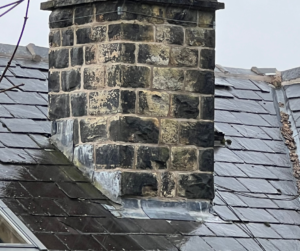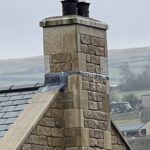
News & Blog
After having major roofing work done, it can be quite frustrating for a home owner to find that they still have water ingress. Even after having a re-roof homeowners may experience dampness on internal wall surfaces, directly below the chimney stack. It is all too easy to jump to the conclusion that the roofer who has carried out the roofing work has done a bad job and the roof is still leaking when actually the problem is being caused by a porous chimney stack. So do you actually still have a roof leak or is the problem being caused by a leaking chimney stack?

Homeowners may sometimes experience dampness showing on internal wall surfaces, directly below a chimney stack, even after having re-roofing work carried out.
This dampness is particularly prevalent if the property has a loft conversion, where the gap between the external roof and the internal plaster work is only 150mm at best!
Domestic homeowners will normally jump to the conclusion that the roof is leaking when actually they have a porous chimney stack.

Porous chimney stack
This image shows the problem with a porous chimney stack. When there is significant rainfall for over an hour, driving rain against the porous masonry, water will soak into the stone like a sponge.
Then gravity allows this water to permeate down wards. Because the lead flashing directly below is fixed in the masonry at a depth of 25 mm, it is very easy for this water to percolate downhill past the lead flashing and reappear some 150mm later on the surface of the internal plaster work, showing up as different colours of dampness.

The problem with a porous and leaking chimney can be exacerbated further if the property has a loft conversion or a room in the roof. This is because the house was likely originally constructed with a large roof void. Normally any water which percolated down the porous masonry would appear on the surface of the exposed masonry in the roof void and would evaporate. This would cause no harm and being out of sight nobody would be any the wiser!
However because the loft has been converted there is literally a gap of 150mm between the lead flashing and internal plaster work within the newly plastered loft conversion. Thus giving the water no time to evaporate before showing itself through the internal plastered walls!
This is particularly true in sandstone and limestone chimney stacks where water will readily soak in through the capillaries within the masonry quite quickly. With gravity pushing the water downhill and appearing on the inside walls, there is not an immediate cure for this other than temporary remedial works or very expensive rebuilding costs!
The first remedial thing you can do for a leaking chimney is treat the surface of the chimney stack with a water repellent. This will certainly help the situation and will repel some of the water.
Also, re-pointing the chimney stack and re-haunching in the very top around the pots will help.
However, because the fundamental reason the chimney stack is leaking is because it is made of a porous masonry material, in extreme weather conditions it is likely you will still see dampness on the inside wall. During prolonged heavy rain the chimney stack will soak up the water until it cannot soak up any more, then manifest in what looks like a roof leak.
The belt-and-braces approach to this leaking chimney problem is to take the chimney stack down to roof level and then rebuild it with a lead damp proof membrane.

New build property
If you look closely at the new build property photograph you can see how the lead is protruding from the base of the chimney stack.
This is built in the chimney and is all the way across the stone bed. It therefore allows the installation of lead flashing directly below the lead tray and will eliminate all water 100%.
This is the only true way to cure water ingress from porous masonry on the chimney stack and thus solve the problem of a leaking chimney.
Your Roofer has probably done a great job of the roof. The felt, the battens, the lead soakers and the lead flashings also. You can’t blame the roofer for the fact, your chimney stack is porous, and that your chimney stack is built from a porous material.
If you have always suffered from damp staining on the internal plastered walls directly around the chimney stack and are thinking of carrying out a re-roof then you should bring this issue to light. It may be that you really don’t need to re-roof your property and discussing this issue with the roofer beforehand so he is aware ensures that he can advise on the best course of action to try to eliminate the problem.

If you're looking to re-roof your property and need a solar or heritage roofing specialist, we can usually offer you an idea of price without visiting your home
Get in touch